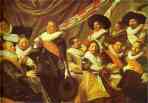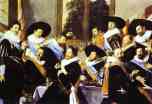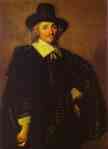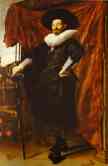Frans Hals Biography
Frans Hals was born into the family of a cloth-maker of Dutch origin in c. 1581-85. The family lived in Flanders, in Micheln, and Frans was born either in Micheln, or Antwerp. Later the family returned to Holland, to Haarlem, where his younger brother, Dirck, also a future painter, was born in 1591.
In 1600-03, Frans studied under Karel van Mander in Haarlem. In 1610, he became a master of the St. Lukas Guild, and in 1644 was elected its deacon. The life of Hals is not eventful and is little known, almost all his life he lived and worked in Haarlem, except for a short trip to Antwerp in 1616 and a visit to Amsterdam in the middle of the 1630s. He knew fame during his lifetime, but died in poverty.
His works before he became thirty are not known. Hals is the most important Dutch portrait painter. His surviving work includes about 300 paintings, and the majority of these are portraits and group portraits. Although after 1626 he became much interested in genre pictures, these still remained portraits, which took most of his time.
Hals certainly was the foremost painter of the Dutch group portrait. Although his very first commission, The Banquet of the Officers of the St. George Civic Guard, 1616, is still fulfilled on traditional examples, he tried to overcome their lining up of several single portraits. In his later group portraits, Banquet of the Officers of the Civic Guard of St. Andrew. c. 1633. The Banquet of the Officers of the St. George Civic Guard. 1627, he revolutionized this branch of painting; these are already not the scenes of official banquet, but merry friendly carousal with free and easy characters. But Hals never presented the scene in a theatrical fashion, as Rembrandt did with his Night Watch, and each of his sitters is given individual and equal attention. The painter was a contemporary of the heroic generation, which shaped the independent Holland and those energetic, brave, straightforward and purposeful people were close to him.
In the 1620s-30s, Hals fulfilled many portraits of Dutch society. In his large single or double portraits, as in the Portrait of Willem van Heythuysen, Flemish elements and the influence of Rubens become evident, with the background showing views and scenic staffage, e.g. Portrait of Isaak Abrahamsz Massa and Beatrix van der Lean. Isaak Massa was a successful silk trader in Russia, where he lived since 1602 till 1609, he knew the Russian language and left an account of the events of Time of Trouble (1598-1613) in Russia. Genre attitude to portrait characterizes Hals’ famous works of the 1620-30s, the models of which were the people from lower layers of the society: visitors of Haarlem taverns, gamehouses, markets, e.g. Gypsy Girl, Malle Babbe, a tavern owner called Haarlem witch.
In the early 1640s, a sudden change takes place in Hals’ work. The new prosperous burghers preferred a beautiful flattering manner, and the painter, whose portraits were not elegant enough for contemporary tastes, started to lose his clients. His constant financial problems, necessity to provide for ten children from his two marriages, added to his somewhat gloomy mood. Children, music, festivals, and careless merry-making leave his paintings. He became more sombre; the vitality is replaced by a pessimistic irony and melancholic resignation about the human condition. His colors now are all hues of black with accents of silver-grey; wide brushstrokes became even freer. Portrait of a Man in a Traveller's Hat.
His last two group portraits were the The Governors of the Old Men's Almhouse at Haarlem. and The Lady-Governors of the Old Men's Almshouse at Haarlem.
The artist died in 1666 in Haarlem. Hals’ pupils included the Ostade brothers, and the imitator of his style, Judith Leyster; he also greatly influenced Steen and Terborch.
Bibliography
Painting of Europe. XIII-XX centuries. Encyclopedic Dictionary. Moscow. Iskusstvo. 1999.
Frans Hals: The Complete Work by Claus Grimm, Jurgen Riehle. Harry N Abrams, 1990.
- The Banquet Of The Officers Of The St. George Civic Guard.

1627. Oil on canvas. 179 x 257.5 cm, Frans-Hals-Museum, Haarlem, Netherlands.
- Banquet Of The Officers Of The Civic Guard Of St. Andrew.

c.1627-33. Oil on canvas. 183 x 277 cm. Frans-Hals-Museum, Haarlem, Netherlands.
- Portrait Of A Gentleman.

c.1650-52. Oil on canvas. The National Gallery of Art, Washington, DC, USA.
- Portrait Of Willem Van Heythuysen.

c.1625-30. Oil on canvas. 204.5 x 134.5 cm. Alte Pinakothek, Munich, Germany.